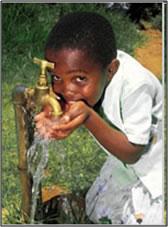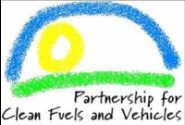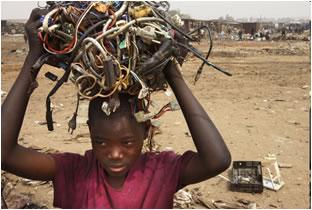EPA Collaboration with Sub-Saharan Africa
EPA’s environmental program in Sub-Saharan Africa is focused on addressing Sub-Saharan Africa’s growing urban and industrial pollution issues impacting people's health, particularly vulnerable populations such as children and the poor. Areas of focus include outdoor and indoor air quality, water quality, and exposure to toxic chemicals.
Learn more about our key activities in Sub-Saharan Africa:
- Highlights
- Current Activities
- Past Activities
Highlights
East African Community countries commit to Regional Harmonization of Lead Paint Limits
September 2016: EPA, UNEP, World Health Organization (WHO), the Government of Tanzania, and IPEN (a global environmental NGO) co-sponsored a workshop in Dar Es Salaam, Tanzania, to develop strategies for regional lead paint laws in the East African Community (EAC), an economic community including Tanzania, Kenya, Rwanda, Uganda and Burundi.
The meeting was attended by Tanzanian and Kenyan government officials from the health and environment ministries and standards bureaus, environmental NGOs and a Tanzanian paint company. Tanzania and Kenya are leaders in the region with the most paint manufacturing and exports to EAC and other African regions.
Because the rest of the EAC countries were not at this meeting, Kenya and Tanzania agreed to spearhead regional harmonization of a 90 ppm total lead limit. The Tanzanian Standards Bureau committed to taking the lead to develop a proposal for the regional limit by October 2016, while the Kenyan Bureau of Standards will explore hosting a regional meeting of all the EAC standards bureaus to finalize the proposal. Due to EAC’s influence as a major trade block in Africa, progress on lead paint laws there will help promote them throughout the continent.
- Learn more about EPA Leadership in the Lead Paint Alliance
Current Activities
Air Quality Management Plan for Accra, Ghana
Urban environments are often where people and pollution come together and require a concerted approach to mitigate exposure and health impacts. Many of the most rapidly growing urban areas in developing countries have limited data, resources and capacity, but significant health and climate impacts from air pollution. The United States Environmental Protection Agency (U.S. EPA) and the Ghana Environmental Protection Agency (Ghana EPA) are working together under the Africa Megacities Partnership to develop an integrated air quality action plan for Accra, Ghana, the capital city, with a focus on short lived climate pollutants. The project will develop and apply an approach that can be modified and applied across African cities.
The project will also demonstrate the applicability and utility of decision support tools developed for use in a wide variety of contexts and data availability situations, such as the Long-range Energy Alternatives Planning System Integrated Benefits Calculator (LEAP-IBC Calculator) and the Environmental Benefits Mapping and Analysis Program-Community Edition (BenMAP-CE) tool. These tools can provide a framework for analyzing the benefits of air pollution control, in terms of healthier populations, climate impacts and economic productivity, as well as the costs of these programs, for comparison and priority setting.
Ghana EPA has already made significant progress using air quality monitoring and analysis, and is interested in enhancing source apportionment techniques and benefits analysis to more clearly identify priorities for reductions. Many other African cities can usefully follow the Ghana EPA example in this area, which serves as a model for the first steps in an air quality management plan.
Urban Drinking Water Quality Laboratory Capacity Building in West Africa
With funding from USAID West Africa, EPA is working with the African Water Association and Ghanaian stakeholders including the Ghanaian Ministry of Water, Works and Housing and the Ghana Water Company Ltd, to build capacity of drinking water quality laboratories in Accra. EPA will be providing training and technical assistance to enhance the capabilities of drinking water quality laboratories, including providing support on laboratory auditing, quality control/quality assurance procedures and developing a Ghanaian Laboratory Manual that can be used as a model for other countries in the region.
The International Water Association (IWA), in cooperation with EPA, provided a Water Safety Plan training to Ghana Water Company, Ltd and other stakeholders in Accra in April 2016. As part of the program, EPA lab experts provided presentations on how laboratory capacity fits into Water Safety Plan development, Quality Systems, and Traceability. This training supports EPA’s work to build laboratory capacity in West Africa.
- Download the training presentation from the Water Safety Portal. (19 pp, 1.4 M, About PDF) Exit
Lead Paint Alliance work in East Africa
EPA participated in a workshop in Ethiopia and Tanzania to promote lead paint laws in East Africa. These workshops were effective in galvanizing actions on lead in paint. After the workshops, Kenya announced it will finalize its law in December 2016. A third workshop is being held in Cameroon to promote harmonization of lead paint laws in West and Central Africa.
- Learn more about EPA Leadership in the Lead Paint Alliance
Global Methane Initiative in Nairobi, Kenya
The Global Methane Initiative (GMI) is a voluntary, multilateral partnership that aims to reduce global methane emissions and to advance the abatement, recovery and use of methane as a valuable clean energy source. In Nairobi, Kenya, EPA is working with the GMI and the Climate and Clean Air Coalition (CCAC) Exit to provide technical expertise to support the Kenyan National Environmental Management Authority (NEMA). EPA is working with NEMA to:
- Improve Kenya’s national Solid Waste Management Strategy.
- Develop an actionable plan or roadmap delineating necessary policies, stakeholders and resources to implement strategy, and engage with a pilot municipality to test approaches to implement the national strategy and to design landfill gas capture gas capture projects on semi-managed landfills to deliver emissions reductions in near/mid-term.
- Develop a template for national actions and a pilot for regional coordination that may be implemented in other priority regions.
- Identify potential national actions for implementation through next CCAC funding cycle.
Past Activities
Good Environmental Governance
As part of its activities to strengthen environmental laws and regulations, build capacity for enforcement and compliance, and promote public participation in environmental decision-making, EPA supported the East Africa Network on Environmental Compliance and Enforcement (EANECE). Exit This work was undertaken in partnership with the International Network on Environmental Compliance and Enforcement (INECE), Exit DANIDA (the Danish aid agency) and the Kenyan Environmental Management Authority (NEMA). Exit Activities included:
- Providing training support in launching the Network.
- Supporting a Network Coordinator based in Nairobi, Kenya, at the Kenyan National Environmental Management Authority (NEMA).
- Providing support to the national enforcement and compliance networks in the five member countries (Rwanda, Burundi, Tanzania, Uganda, and Kenya) to enable them to strengthen their domestic programs.
- Providing training in priority areas such as the principles of enforcement and compliance, environmental inspections, and criminal enforcement.
- Providing web-based and other mechanisms to build relationships among experts in the region for enhanced cooperation and share knowledge and experience.
Water and Sanitation
EPA worked to improve public health through increasing the capacity of urban providers in Sub-Saharan Africa to deliver safe drinking water in a sustainable way through piped water supply systems, through the development and implementation of Water Safety Plans (WSPs). This work was conducted in partnership with the International Water Association (IWA), Exit the World Health Organization (WHO), ExitUnited Nations-Habitat Exit and local water utilities.
The goal of EPA and IWA’s East Africa WSP program was to establish a sound basis for scaling-up WSP implementation across the Africa region through the implementation of WSPs and the creation of long-term supporting mechanisms to ensure that a significant proportion of urban populations in the African continent are consistently supplied with safe drinking water through the implementation of WSPs.

Project elements included the formation of three Water Operator Partnerships (WOPs), each working with three utilities, to guide each other in the development of WSPs over 18 months. Each utility created a WSP. The project also included WSP training and the development of an online Water Safety Portal for Africa Exit to give an overview of the Africa WSP program with case studies and tools.
EPA and partner countries also created the Africa Water Safety Plan Network Exit, with the mission to achieve reliable, consistent and equitable supplies of safe drinking water in Africa by promoting the implementation of Water Safety Plans through information dissemination, knowledge sharing and support for capacity building. Members include EPA, IWA, WHO, UN-HABITAT, Aquaya, the African Water Association, GIZ, and Cap-NET (UNDP).
Ambient Air Quality
EPA has been involved in improving vehicle fuels and promoting emissions control technologies to improve air quality in urban areas.
As a founding Partner of the Partnership for Clean Fuels and Vehicles (PCFV), EPA was involved in providing support to Sub-Saharan Africa (SSA) in phasing out of leaded gasoline, which occurred throughout the region in January 2006. Building on this success, EPA worked through PCFV to support Sub-Saharan African countries to lower sulfur in fuels.

A decade ago in SSA, sulfur levels range between 3,000 to 10,000 ppm. After working with the PCFV, many SSA countries today have introduced lower sulfur fuel standards and the levels range from 50-500 ppm. Sulfur in fuels, particularly in diesel fuel, results in the emission of high levels of fine particulates which can be inhaled deep into the lungs causing cardiovascular and respiratory disease.
EPA has assisted in the effort by providing funding, technical and policy advice and public outreach information to achieve this ultimate goal. EPA has provided assistance to the PCFV on promoting clean vehicles technologies, particularly the use of catalytic converters.
Global Methane Initiative
As noted above, the Global Methane Initiative (GMI) is a voluntary, multilateral partnership that aims to reduce global methane emissions and to advance the abatement, recovery and use of methane as a valuable clean energy source. Past activities in Sub-Saharan Africa under the GMI include:
Accra, Ghana: EPA worked with local government officials at the Accra Metropolitan Assembly (AMA), national government officials from the Ghana Environmental Protection Agency, representatives of private companies in the waste management sector, and other partners to develop and implement a project to address short-lived climate pollutant (SLCP) emissions from the solid waste sector in Accra. The Accra Work Plan (approved by the AMA in February 2014) serves as the basis for this collaboration.
Addis Ababa, Ethiopia: Under the Climate and Clean Air Coalition (CCAC), EPA worked with local government officials at the City Government of Addis Ababa (CGAA) and other local partners to develop and implement a project to address SLCP emissions from the solid waste sector in Addis Ababa. The Addis Ababa Work Plan (approved by the city in June 2015) serves as the basis for this collaboration. Subsequently, the USEPA in partnership with the Solid Waste Institute for Sustainability and the Horn of Africa Regional Environment Centre (HoA-REC) provided technical assistance and capacity building for the closure of the Addis Ababa dumpsite and the opening of their new sanitary landfill in the form of technical advice, procurement guidance, and onsite training at the University of Texas Arlington and City of Denton, Texas landfill.
Toxic Substances: E-Waste

In support of the goals of the National Strategy for Electronics Stewardship, EPA is working with partners in Africa to develop and support a pilot project on the sustainable management of electronic waste, including:
- Ethiopia: Through the UNU-StEP cooperation, EPA worked in Ethiopia with government officials, as well as industry and NGO stakeholders, to develop a plan for sustainability of a demanufacturing facility that can safely recycle end-of-life used electronics. Other efforts in Africa include strengthening efforts to improve information on the e-waste flows.
- Nigeria Person-in-the-Port Project: In 2015, the United Nations University Solving the E-waste Problem (Step) Initiative, with financial support from EPA and the German Senior Expert Service, launched a Person-in-the Port (PiP) Project in Lagos, Nigeria. Through the PiP Project, a Nigerian e-waste expert collected qualitative and quantitative information on imports of electronics into the Port of Lagos over a period of 6 months. Working with the Basel Convention Coordinating Center for Africa located in Ibadan, Nigeria, the PiP was able to consult with Nigeria’s regulatory agency (NESREA), the Nigerian Customs Services (NCS), and the Nigerian Port Authority (NPA) and gain access to shipments and importation documents. In addition to visually assessing contents of shipments, the PiP was able to collect information on country of origin, the quality of the imports, any discrepancies in the contents versus the shipping label and other useful information to help assess and evaluate the used electronics being imported. This effort could serve as a model for countries with e-waste import problems that wish to gain a better understanding of the flows of used electronics and e-waste.
Learn more:
- National Strategy for Electronics Stewardship
- EPA Efforts Cleaning Up Electronic Waste (E-Waste)
- UNU-StEP Person in the Port Project (PDF)(4 pp, 2.1 M, About PDF)
